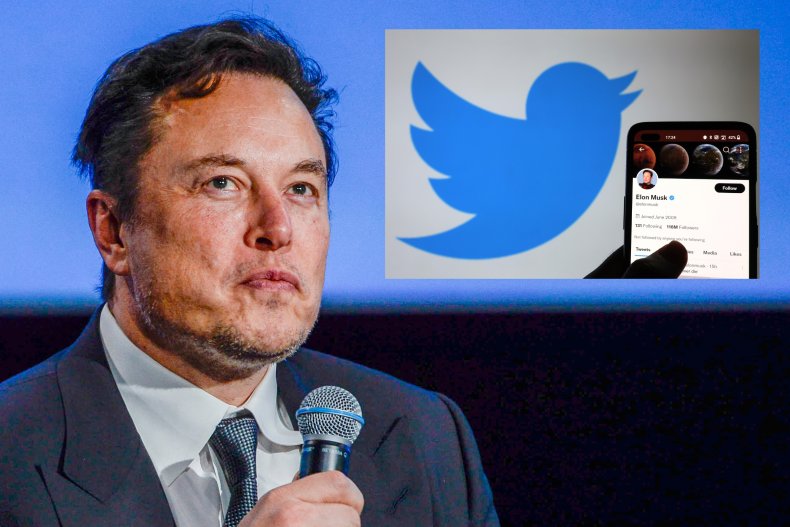Twitter has quietly removed device info from tweets, weeks after new CEO Elon Musk was relentlessly mocked when it was pointed out that he had criticized Apple on the platform while using an iPhone.
Musk, whose deal to take over Twitter was finalized in October, tweeted about tech giant Apple several times in late November, alleging the company has threatened to withhold Twitter from its App Store.
The South African-born billionaire also accused Apple of hating free speech—while tagging the company’s CEO Tim Cook—and discussed the “secret 30% tax” put on the App Store.

CARINA JOHANSEN/NTB/AFP via Getty Images;/Nathan Stirk/Getty Images
While many were riled up by Musk’s comments, others saw the funny side after every tweet from the Tesla CEO was followed by the words “Twitter for iPhone.”
The potential for any such embarrassment has since been eliminated, as it was pointed out over the weekend that the feature that identifies which device Twitter users are tweeting from has been removed.
On Saturday, a Twitter user shared a highlighted screenshot of a blank tweet, along with the caption: “Twitter has removed the ability to see which device a tweet comes from. (Twitter for iPhone, Twitter for Android).”
Hours later, the post caught the attention of Musk, who wrote in a quote tweet: “Hallelujah!!”
Despite this, one Twitter user shared that they could still decipher the device Musk had used to post that tweet, explaining: “FYI – This is only implemented on the frontend. The Twitter API [application programming interface] still shows the device data in the API response. He tweeted that from an iPhone.”
Another used it as an opportunity to bring up the mockery of weeks past, writing in a direct address to Musk: “You removed it because we made fun of you for using an iPhone while poking fun at Tim Cook.”
While the timing of the feature’s removal has led a number of Twitter users to believe that Musk implemented it to eliminate further embarrassment, the move was actually on the cards shortly after the businessman acquired the platform.
In mid-November, Musk apologized in a Twitter thread for the platform being “super slow” in many countries as he explained a string of changes to come.
Concluding the thread, he stated that “we will finally stop adding what device a tweet was written on (waste of screen space & compute) below every tweet. Literally no one even knows why we did that.”
And we will finally stop adding what device a tweet was written on (waste of screen space & compute) below every tweet. Literally no one even knows why we did that …
— Elon Musk (@elonmusk) November 14, 2022
Meanwhile, millions of Twitter users have expressed a desire for Musk to step down as head of the platform in a poll conducted by the entrepreneur, after a tumultuous few weeks that have seen him advocate free speech while moving to silence some of his most strident critics.
On his official Twitter account on Sunday, Musk wrote: “Should I step down as head of Twitter? I will abide by the results of this poll.”
Around 57.5 percent of the 17.5 million votes said he should step down, while 42.5 percent said he should stay in the post, as of press time.
However, last month, Musk stated in court that he would step down and appoint a new CEO of the company.
Musk, the world’s second-richest man, is also CEO of electric carmaker Tesla, as well as space company SpaceX. He leads nanotechnology business Neuralink and The Boring Company, which constructs infrastructure and tunnels.
The businessman bought Twitter for $44 billion in late October. The deal nearly fell through after Musk pulled out, accusing the social media site of not being transparent about the number of bots and spam accounts on its platform.
Since taking over the social media site, Musk has attracted controversy over his reforms.
He fired more than half of Twitter’s staff and allowed back previously banned users, including former President Donald Trump.
Musk has also introduced an $8-a-month paid Twitter verification service, which has led to many accounts masquerading as celebrities and politicians.
Last week, he moved to suspend several accounts of journalists reporting on him, a move that was widely criticized as Musk has long claimed to be an advocate of “free speech.”
Musk said he suspended the accounts of these journalists because they endangered his family by “doxing” or sharing non-public information, about his location.
He later created a poll on his Twitter account about whether the journalists’ suspensions should be lifted. Some 58.7 percent said they should be reversed, so he lifted the suspensions. The journalists were from organizations including CNN, The New York Times and The Washington Post.




